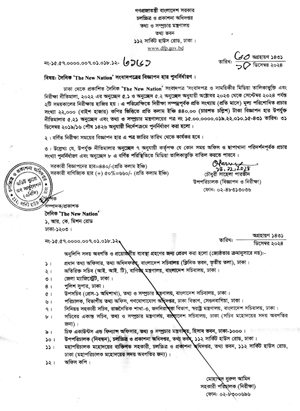Staff Reporter :
People from all walks of life, including ministers, political leaders, freedom fighters and cultural activists, paid their last tributes to Major (Retd) Ziauddin Ahmed, a sub-sector commander during Bangladesh’s Liberation War in 1971, at the Central Shaheed Minar in the capital on Sunday.
A guard of honor was also given to Ziauddin Ahmed when his body was taken to the Central Shaheed Minar at 3pm.
The body covered by national flag was kept there for two hours so that people can pay their homage to the valiant Freedom fighter.
Later, the body of Ziauddin Ahmed was taken to his birthplace Pirojpur for Janaza.
Ziauddin Ahmed, commander of the Sundarbans sub-sector under Sector 9 during the Liberation War of 1971, breathed his last at Mount Elizabeth Hospital in Singapore while undergoing treatment at early hours of Friday.
He was 67.
His body was taken to Dhaka from Singapore on Saturday night.
Earlier on July 1, he was admitted to Square Hospital in Dhaka with kidney and liver diseases.
As his condition deteriorated, Ziauddin was taken to Singapore in mid-July.
Ziauddin Ahmed, renowned as the ‘Mukuthin Somrat’ (crownless king) of the Sundarbans among his countless admirers, was a strict military leader reputed to have run the most disciplined force during the war.
He was also appointed as a commander of the first East Bengal Regiment under Z-force of the Freedom fighters.
Ziauddin was commissioned as a second lieutenant of the Pakistan Army in 1969. He was serving the army in the then West Pakistan when the Liberation War broke out in 1971.
The patriot managed to flee from West Pakistan in July and joined the Liberation War thereafter.
Ziauddin was commissioned as a major of the Bangladesh Army in 1975. He was serving at the Directorate General of Forces Intelligence (DGFI) during the brutal bloodbath of August 15, 1975.
Following the killing of Bangabandhu on August 15, Ziauddin joined the so-called Day of Uprising of Soldier and People (otherwise known as National Revolution and Solidarity Day) on November 7 the same year under the leadership of Col Taher.
Later, he stood for the Biplobi Sainik Sangshta (Revolutionary Sepoy’s Organisation) in opposing the military rule and took shelter in the Sundarbans with his followers as part of the resistance.
Ziaduddin was arrested in an army operation in the Sundarbans in 1976. Along with many other descanting military officials and political leaders, he was sentenced to life imprisonment by a military court.
In 1980, he was freed on presidential clemency.
After a brief stay away in Singapore in the early 80s, Ziauddin returned to the country. In 1989, he was elected the chairman of Pirojpur municipality. He later formed a non-political organisation, named ‘Sundarban Banchao’ (Save the Sundarbans), uniting the fishermen of the Sundarbans.
He was the chairman of Dubla Fishermen Group till the last day of his life.
People from all walks of life, including ministers, political leaders, freedom fighters and cultural activists, paid their last tributes to Major (Retd) Ziauddin Ahmed, a sub-sector commander during Bangladesh’s Liberation War in 1971, at the Central Shaheed Minar in the capital on Sunday.
A guard of honor was also given to Ziauddin Ahmed when his body was taken to the Central Shaheed Minar at 3pm.
The body covered by national flag was kept there for two hours so that people can pay their homage to the valiant Freedom fighter.
Later, the body of Ziauddin Ahmed was taken to his birthplace Pirojpur for Janaza.
Ziauddin Ahmed, commander of the Sundarbans sub-sector under Sector 9 during the Liberation War of 1971, breathed his last at Mount Elizabeth Hospital in Singapore while undergoing treatment at early hours of Friday.
He was 67.
His body was taken to Dhaka from Singapore on Saturday night.
Earlier on July 1, he was admitted to Square Hospital in Dhaka with kidney and liver diseases.
As his condition deteriorated, Ziauddin was taken to Singapore in mid-July.
Ziauddin Ahmed, renowned as the ‘Mukuthin Somrat’ (crownless king) of the Sundarbans among his countless admirers, was a strict military leader reputed to have run the most disciplined force during the war.
He was also appointed as a commander of the first East Bengal Regiment under Z-force of the Freedom fighters.
Ziauddin was commissioned as a second lieutenant of the Pakistan Army in 1969. He was serving the army in the then West Pakistan when the Liberation War broke out in 1971.
The patriot managed to flee from West Pakistan in July and joined the Liberation War thereafter.
Ziauddin was commissioned as a major of the Bangladesh Army in 1975. He was serving at the Directorate General of Forces Intelligence (DGFI) during the brutal bloodbath of August 15, 1975.
Following the killing of Bangabandhu on August 15, Ziauddin joined the so-called Day of Uprising of Soldier and People (otherwise known as National Revolution and Solidarity Day) on November 7 the same year under the leadership of Col Taher.
Later, he stood for the Biplobi Sainik Sangshta (Revolutionary Sepoy’s Organisation) in opposing the military rule and took shelter in the Sundarbans with his followers as part of the resistance.
Ziaduddin was arrested in an army operation in the Sundarbans in 1976. Along with many other descanting military officials and political leaders, he was sentenced to life imprisonment by a military court.
In 1980, he was freed on presidential clemency.
After a brief stay away in Singapore in the early 80s, Ziauddin returned to the country. In 1989, he was elected the chairman of Pirojpur municipality. He later formed a non-political organisation, named ‘Sundarban Banchao’ (Save the Sundarbans), uniting the fishermen of the Sundarbans.
He was the chairman of Dubla Fishermen Group till the last day of his life.




